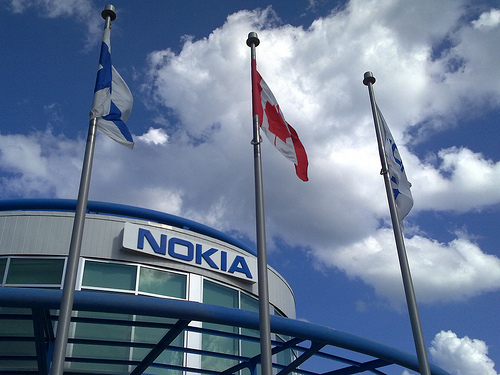Posted by Jamie Forestell
Ok, so one day Stephen Elop wakes up and has a vision: our product sucks and we need to do something about it. Next day, a press event is scheduled with Microsoft and Nokia both to annouce the new partnership, and the dismissal of Symbian. Although Symbian is not the #1 OS in smartphones, and may lack several components the competition has, Elop’s timing couldnt have been worse. We are one week away from the Mobile World Congress in Barcelona, when all the major smartphone companies are planning to announce their 2011 roadmaps and strategies. So here we have Nokia, about to announce several new phones, with DOA operating systems. Will you pay for a Nokia phone in 2011? Will you wait until a Nokia phone is ready with a windows phone 7 operating system? Or will you take advantage of the several amazing smartphones planned in 2011, sign contracts for a few years, and leave Nokia to hang? Chances are, the latter of the three is going to be the choice many consumers will make. Does Nokia have the staying power to survive that long with their upcoming products?
[spoiler]Nokia outlines new strategy, introduces new leadership, operational structure
February 11, 2011
Nokia Corporation
Stock exchange release
February 11, 2011 at 09.45 (CET+1)
London, UK – Nokia today outlined its new strategic direction, including changes in leadership and operational structure to accelerate the company’s speed of execution in a dynamic competitive environment.
Major elements of the new strategy include:
– Plans for a broad strategic partnership with Microsoft to build a new global mobile ecosystem; Windows Phone would serve as Nokia’s primary smartphone platform.
– A renewed approach to capture volume and value growth to connect “the next billion” to the Internet in developing growth markets
– Focused investments in next-generation disruptive technologies
– A new leadership team and organizational structure with a clear focus on speed, results and accountability
“Nokia is at a critical juncture, where significant change is necessary and inevitable in our journey forward,” said Stephen Elop, Nokia President and CEO. “Today, we are accelerating that change through a new path, aimed at regaining our smartphone leadership, reinforcing our mobile device platform and realizing our investments in the future.”
Nokia plans to form a strategic partnership with Microsoft to build a global mobile ecosystem based on highly complementary assets. The Nokia-Microsoft ecosystem targets to deliver differentiated and innovative products and have unrivalled scale, product breadth, geographical reach, and brand identity. With Windows Phone as its primary smartphone platform, Nokia would help drive the future of the platform by leveraging its expertise on hardware optimization, software customization, language support and scale. Nokia and Microsoft would also combine services assets to drive innovation. Nokia Maps, for example, would be at the heart of key Microsoft assets like Bing and AdCenter, and Nokia’s application and content store would be integrated into Microsoft Marketplace. Under the proposed partnership, Microsoft would provide developer tools, making it easier for application developers to leverage Nokia’s global scale.
With Nokia’s planned move to Windows Phone as its primary smartphone platform, Symbian becomes a franchise platform, leveraging previous investments to harvest additional value. This strategy recognizes the opportunity to retain and transition the installed base of 200 million Symbian owners. Nokia expects to sell approximately 150 million more Symbian devices in the years to come.
Under the new strategy, MeeGo becomes an open-source, mobile operating system project. MeeGo will place increased emphasis on longer-term market exploration of next-generation devices, platforms and user experiences. Nokia still plans to ship a MeeGo-related product later this year.
In feature phones, Nokia unveiled a renewed strategy to leverage its innovation and strength in growth markets to connect the next billion people to their first Internet and application experience.
New leadership team, operational structure
This new strategy is supported by significant changes in Nokia’s leadership, operational structure and approach. Effective today, Nokia has a new leadership team with the commitment, competencies and innovative thinking needed in today’s dynamic environment.
The Nokia Leadership Team, previously the Group Executive Board, will consist of the following members: Stephen Elop, Esko Aho, Juha Akras, Jerri DeVard, Colin Giles, Rich Green, Jo Harlow, Timo Ihamuotila, Mary McDowell, Kai Oistamo, Tero Ojanpera, Louise Pentland and Niklas Savander.
Alberto Torres has stepped down from the management team, effective February 10 to pursue other interests outside the company.
The renewed governance will expedite decision-making and improve time-to-market of products and innovations, placing a heavy focus on results, speed and accountability. The new strategy and operational structure are expected to have significant impact to Nokia operations and personnel.
New company structure
As of April 1, Nokia will have a new company structure, which features two distinct business units: Smart Devices and Mobile Phones. They will focus on Nokia’s key business areas: high-end smartphones and mass-market mobile phones. Each unit will have profit-and-loss responsibility and end-to-end accountability for the full consumer experience, including product development, product management and product marketing.
Smart Devices will be responsible for building Nokia’s leadership in smartphones and will be led by Jo Harlow. The following sub-units now in Mobile Solutions will move under Smart Devices:
– Symbian Smartphones
– MeeGo Computers
– Strategic Business Operations
To support the planned new partnership with Microsoft, Smart Devices will be responsible for creating a winning Windows Phone portfolio.
Mobile Phones will drive Nokia’s “web for the next billion” strategy. Mobile Phones will leverage its innovation and strength in growth markets to connect the next billion people and bring them affordable access to the Internet and applications. The Mobile Phones unit will be led by Mary McDowell.
Markets will be responsible for selling products, executing compelling marketing and communications, creating a competitive local ecosystem, sourcing, customer care, manufacturing, IT and logistics across all Nokia products. It will be headed by Niklas Savander.
Services and Developer Experience will be responsible for Nokia’s global services portfolio, developer offering, developer relations and integration of partner service offerings. Tero Ojanpera will lead the Services and Developer Experience unit in an acting capacity.
NAVTEQ, an integral part of Nokia’s location and advertising business, will be headed by Larry Kaplan, and continue as a separate reporting entity.
The CTO Office will be responsible for Nokia’s technology strategy and forward-looking technology activities, including Nokia Research Center. It will be headed by Rich Green.
Design, responsible for Nokia product and user experience design, will be led by Marko Ahtisaari.
The CFO Office, responsible for all financial activity, will be headed by Timo Ihamuotila.
Corporate Development, responsible for driving implementation of Nokia’s ecosystem strategy and strategic partnerships, will be headed by Kai Oistamo.
Corporate Relations & Responsibility, responsible for Nokia’s government and public affairs, sustainable development and social responsibility, will be led by Esko Aho.
Human Resources will be led by Juha Akras.
Legal and Intellectual Property will be led by Louise Pentland.
Nokia Siemens Networks continues in the Nokia Group as a separate reporting entity.
Please visit www.nokia.com/press for press materials.
About Nokia
At Nokia, we are committed to connecting people. We combine advanced technology with personalized services that enable people to stay close to what matters to them. Every day, more than 1.3 billion people connect to one another with a Nokia device – from mobile phones to advanced smartphones and high-performance mobile computers. Today, Nokia is integrating its devices with innovative services through Ovi (www.ovi.com), including music, maps, apps, email and more. Nokia’s NAVTEQ is a leader in comprehensive digital mapping and navigation services, while Nokia Siemens Networks provides equipment, services and solutions for communications networks globally.
FORWARD-LOOKING STATEMENTS
It should be noted that certain statements herein which are not historical facts are forward-looking statements, including, without limitation, those regarding: A) the intention to form a strategic partnership with Microsoft to combine complementary assets and expertise to form a global mobile ecosystem and to adopt Windows Phone as our primary smartphone platform, including the expected plans and benefits of such partnership; B) the timing and expected benefits of our new strategy, including expected operational and financial benefits and targets as well as changes in leadership and operation structure; C) the timing of the deliveries of our products and services and their combinations; D) our ability to develop, implement and commercialize new technologies, products and services and their combinations; E) expectations regarding market developments and structural changes; F) expectations and targets regarding our industry volumes, market share, prices, net sales and margins of products and services; G) expectations and targets regarding our operational priorities and results of operations; H) the outcome of pending and threatened litigation; I) expectations regarding the successful completion of acquisitions or restructurings on a timely basis and our ability to achieve the financial and operational targets set in connection with any such acquisition or restructuring; and J) statements preceded by “believe,” “expect,” “anticipate,” “foresee,” “target,” “estimate,” “designed,” “plans,” “will” or similar expressions. These statements are based on management’s best assumptions and beliefs in light of the information currently available to it. Because they involve risks and uncertainties, actual results may differ materially from the results that we currently expect. Factors that could cause these differences include, but are not limited to: 1) whether definitive agreements can be entered into with Microsoft for the potential partnership in a timely manner, or at all, and on terms beneficial to us; 2) our ability to continue to innovate and maintain the vibrancy of our Symbian-based smartphones during the negotiation of the Microsoft partnership and thereafter; 3) the negotiation and implementation of the Microsoft partnership will require significant time, attention and resources of our senior management and others within the company potentially diverting their attention from other aspects of our business; 4) in choosing to negotiate a partnership with Microsoft and utilize Windows Phone as our primary smartphone platform, we may forego more competitive alternatives achieving greater acceptance and profitability in the smartphone market; 5) the Microsoft Windows Phone smartphone platform may not be preferred by application developers, content providers and other partners impairing our ability to build a sufficiently competitive ecosystem for our smartphones; 6) the Microsoft partnership may not achieve the stated goal of producing smartphones which are differentiated from those of our competitors and preferred by our customers and consumers in the expected timeframe, or at all; 7) our ability to change our business model, way of working and culture sufficiently to work effectively and efficiently with Microsoft in order to realize the stated benefits of the partnership in a timely manner, or at all; 8) our ability to effectively and smoothly implement our new leadership and operational structure and to realize the anticipated benefits in a timely manner; 9) the implementation of the Microsoft partnership and the new operational structure may cause disruption and dissatisfaction among employees potentially reducing focus and productivity in some or all areas of our business; as well as the risk factors specified on pages 11-32 of Nokia’s annual report Form 20-F for the year ended December 31, 2009 under Item 3D. “Risk Factors.” Other unknown or unpredictable factors or underlying assumptions subsequently proving to be incorrect could cause actual results to differ materially from those in the forward-looking statements. Nokia does not undertake any obligation to publicly update or revise forward-looking statements, whether as a result of new information, future events or otherwise, except to the extent legally required.
[/spoiler]
 Tek Tok Canada Canadian Technology News & Reviews
Tek Tok Canada Canadian Technology News & Reviews


3 comments
Pingback: Tweets that mention Nokia to ditch Symbian for Microsoft Phone 7 | Tek Tok Canada -- Topsy.com
Pingback: Sid Carton
Pingback: Martin Stringfellow